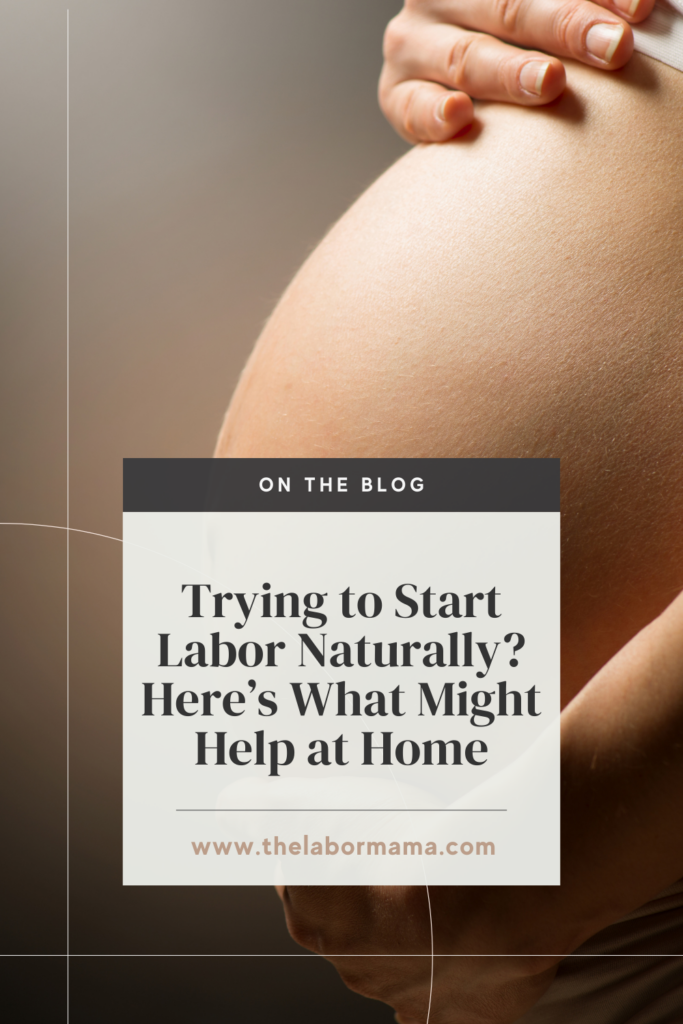If you’re here, there’s a good chance you’re full-term (or close!) and more than ready to meet your baby. Whether you’re hoping to avoid a medical induction or just feeling done with pregnancy, you’re probably wondering how to start labor at home.
The truth? There’s no single magic trick—but there are evidence-based ways to support your body as it gets ready. And there are also plenty of myths and hype floating around that might sound convincing but don’t do much at all.
This post is your go-to guide for exploring the natural labor induction methods we’ve covered so far, aka–how to start labor at home. Each section gives a quick overview and links you straight to the deeper dive—because context matters, and safety always comes first.
Before we go much deeper into how to start labor at home with natural induction methods – Who is The Labor Mama and Why Am I Here?
Hey friend! I’m Lo – also known around here and social media as The Labor Mama. I’ve spent my nursing career in labor, delivery, and postpartum, have birthed 4 of my own babies, have labored thousands of mamas at the bedside, have taught thousands of students online, and have even delivered a few speedy little babies with my bare hands (oops).
Here at TLM, I offer online classes about birth, postpartum, newborn care, and breastfeeding to empower you the way everyone should be. The education + support I offer gives you experience, evidence, and empathy; you’re getting all of my years of “clinical” RN knowledge, honestly combined with my real experiences as a mama and a nurse. These are not your average hospital classes (those won’t do it, I promise), and honestly, birth, postpartum, and breastfeeding don’t follow a textbook or protocol anyway. You need to know so much more than that!
If you want to connect with me further, head to Instagram. There are hundreds of thousands of us over there learning together daily.
A note: This post may include affiliate links. This means if you make a purchase after clicking a link, I will earn a small commission (thank you)! Rest assured, this comes at no additional cost to you. You can read TLM’s full disclosure here.
What Actually Makes Labor Start?
Before you start pineapple snacking or bouncing on a ball, it helps to know how labor actually begins before you start trying to figure out how to start labor at home. Spoiler: it’s not just your cervix—it’s your hormones, uterus, baby, and brain working together. This overview of the physiology of labor explains what’s really going on in those final days and why “waiting it out” isn’t as passive as it sounds.
Membrane Sweeps
If your provider has mentioned a membrane sweep, here’s what you need to know: it’s a manual technique performed during a cervical check to potentially trigger prostaglandins and contractions. This guide to membrane sweeps breaks down how it works, when it’s offered, and what results to expect.
The Miles Circuit
This movement-based method is all about helping your baby settle into a great position. The Miles Circuit uses a three-part sequence to open the pelvis, align baby, and potentially encourage progress—especially if labor feels stalled or slow to start.
Eating Dates
There’s actual research behind this one: eating dates in the final weeks of pregnancy may help with cervical ripening and shorter labors. Wondering how many to eat and when to start? Check out the rundown on date consumption and labor.
Evening Primrose Oil
Evening Primrose Oil (EPO) is often recommended to soften the cervix—but the research is mixed and there are some important cautions to keep in mind. This balanced look at EPO outlines both the pros and the real risks.
Pineapple + Spicy Food
It’s a classic suggestion—eat something spicy or load up on pineapple and boom, labor starts. But what’s hype and what’s actually helpful? This evidence-based take on labor-inducing foods explains the reality (and what you might want to skip).
Midwives Brew
A powerful and controversial option, Midwives Brew is a mix of castor oil, almond butter, lemon verbena tea, and apricot juice. It’s intense—and not something to try casually. If you’re curious, this step-by-step guide to Midwives Brew shares how to make it, when to consider it, and what to watch out for.
Red Raspberry Leaf Tea
This herbal tea is less about kicking off labor and more about prepping your uterus to work efficiently once things get going. Learn how and when to use it with the RRL tea breakdown.
Castor Oil
A long-used method that’s still around for a reason—castor oil can stimulate contractions by irritating the intestines. But it’s not without risks, especially if taken incorrectly. This deep dive on castor oil for induction outlines safe dosages, timing, and what to avoid.
Sex + Nipple Stimulation
Yep, this one has some science to it! Semen contains prostaglandins, orgasms can cause contractions, and nipple stimulation can release oxytocin—all of which may help trigger labor. If you’re wondering how to make it effective (and safe), check out the guide to intimacy and labor induction.
Acupressure, Acupuncture, and Chiropractic Care
Bodywork methods like acupressure, acupuncture, and chiropractic care focus on alignment, nervous system balance, and pressure points. While research is still evolving, many mamas find these methods help their bodies get into good alignment (and peace) for labor prep. This resource on hands-on care shares what to expect and how to find a qualified provider.
To Wrap Up This Post About How To Start Labor At Home…Do Natural Labor Induction Methods Work?
Some do. Some don’t. And none of them will override your body if it’s not ready. The other thing I always want you to know is that people toss out the word “induction” a lot, but that vocabulary isn’t great for most of these labor prep methods. So often, what people are really talking about (or what the hoped for outcome is) is getting the body (and the cervix) ready for labor. Then, when contractions do start, that body is that much more likely to kick into gear.
Natural methods can be powerful support tools—but labor begins when your body and your baby are both on board. The goal isn’t to “force” things, but to gently create the best conditions for labor to begin on its own.
That’s why Your Body, Your Birth covers all of this (and more!) in depth. From the science to the strategies, you’ll get real guidance to help you feel informed, empowered, and ready for what’s ahead. And we’re never forcing anyone, or your body, to do anything.
You’re not alone in this. You’ve got this, mama.
xx-Lo
More resources (and freebies!) for you to take a peek at:
- Comprehensive Birth Plan and Birth Priorities templates
- A complete Third Trimester Checklist
- The RN + mama of 4 Ultimate Packing List
- The Labor Mama online birth, baby and breastfeeding classes for every family
Liked this post? Don’t forget to Pin it!






